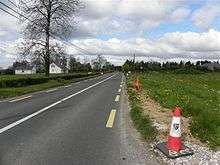Clontycarnaghan

Clontycarnaghan (from Irish: Cluainte Chearnacháin meaning "Kernaghan’s Meadows") is a townland in the civil parish of Templeport, County Cavan, Ireland. It lies in the Roman Catholic parish of Templeport and barony of Tullyhaw.
Geography
Clontycarnaghan is bounded on the north by Mullanacre Upper townland in Tomregan parish, on the west by Corneen and Munlough North townlands, on the south by Urhannagh and Bofealan townlands and on the east by Sralahan and Moher townlands in Tomregan parish. Its chief geographical features are Slieve Rushen mountain on whose southern slope it lies, the Crooked River (Ireland), waterfalls, mountain bogs, forestry plantations, spring wells and dug wells. It forms part of the Slieve Rushen Bog Natural Heritage Area
Clontycarnaghan is traversed by the national secondary N87 road (Ireland), minor roads and rural lanes.
The townland covers 371 statute acres.[1]
History
Until the 19th century the modern townland of Corneen formed a sub-division of Clontycarnaghan.
The 1609 Baronial Map depicts the townland as Cloncarnagh.[2]
The 1652 Commonwealth Survey spells the name as Cloontikarnaghan.
The 1665 Down Survey map depicts it as Carnagh.[3]
William Petty's 1685 map depicts it as Carnagh.
In the Plantation of Ulster by grant dated 4 June 1611, along with other lands, King James VI and I granted the two polls of Clonekarnehan to Callo O'Gowne, gentleman.
The O'Gowne lands in Clontycarnaghan were confiscated in the Cromwellian Act for the Settlement of Ireland 1652 and were distributed as follows-
The 1652 Commonwealth Survey lists the proprietor as Thomas Thornton and the tenant as Hugh O'Backaghan.
In the Hearth Money Rolls of 1662 there were two people paying the Hearth Tax in- Clunticarnagh- William Mathers and Walter Rice.
A grant dated 3 November 1666 was made by King Charles II of England to Sir Tristram Beresford, 1st Baronet which included, inter alia, the lands of Clantacannagh. By grant dated 11 September 1670 from King Charles II of England to said Sir Tristram Beresford, the said lands of Clantacannagh were included in the creation of a new Manor of Beresford.
The 1790 Cavan Carvaghs list spells the name as Clontecarnahan.[4]
The Tithe Applotment Books for 1827 list sixteen tithepayers in the townland.[5]
In 1841 the population of the townland was 121, being 50 males and 71 females. There were twenty-two houses in the townland, of which two were uninhabited.[6]
In 1851 the population of the townland was 72, being 36 males and 36 females, the reduction being due to the Great Famine (Ireland). There were twenty-one houses in the townland, of which two were uninhabited.[7]
Griffith's Valuation of 1857 lists twenty four landholders in the townland.[8]
In 1861 the population of the townland was 104, being 45 males and 59 females. There were nineteen houses in the townland, of which one was uninhabited.[9]
In 1871 the population of the townland was 87, being 45 males and 42 females. There were sixteen houses in the townland, all were inhabited.[10]
In 1881 the population of the townland was 80, being 43 males and 37 females. There were seventeen houses in the townland, all were inhabited.[11]
In 1891 the population of the townland was 69, being 30 males and 39 females. There were sixteen houses in the townland, all were inhabited.[12]
In the 1901 census of Ireland, there are sixteen families listed in the townland, [13] and in the 1911 census of Ireland, there are seventeen families listed in the townland.[14]
Antiquities
The only structures of historical interest in the townland seem to be footsticks and footbridges over the Crooked River.
References
- ↑ "IreAtlas". Retrieved 29 February 2012.
- ↑ National Archives Dublin
- ↑ Trinity College Dublin: The Down Survey of Ireland.
- ↑
- ↑
- ↑
- ↑
- ↑
- ↑
- ↑
- ↑
- ↑
- ↑ Bawnboy/Clontycarnaghan
- ↑ Bawnboy/Clontycarnaghan/ Census of Ireland 1911
